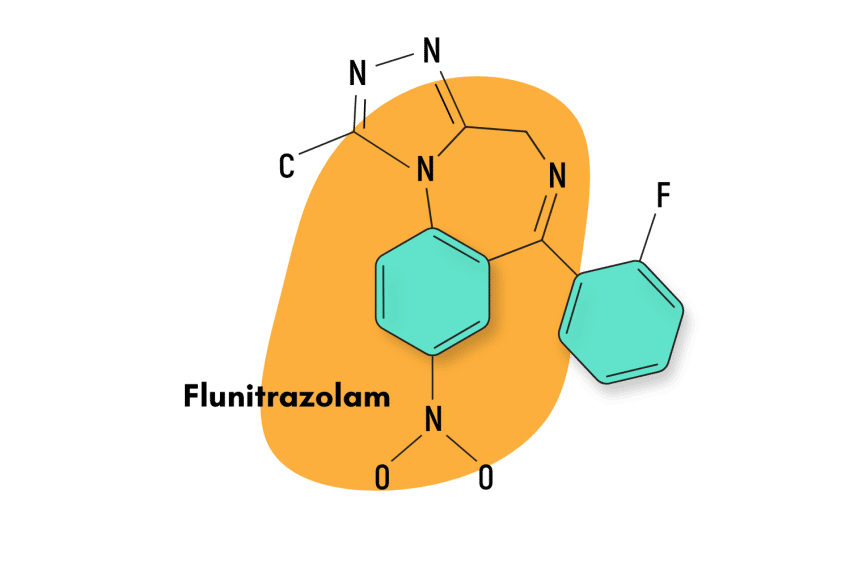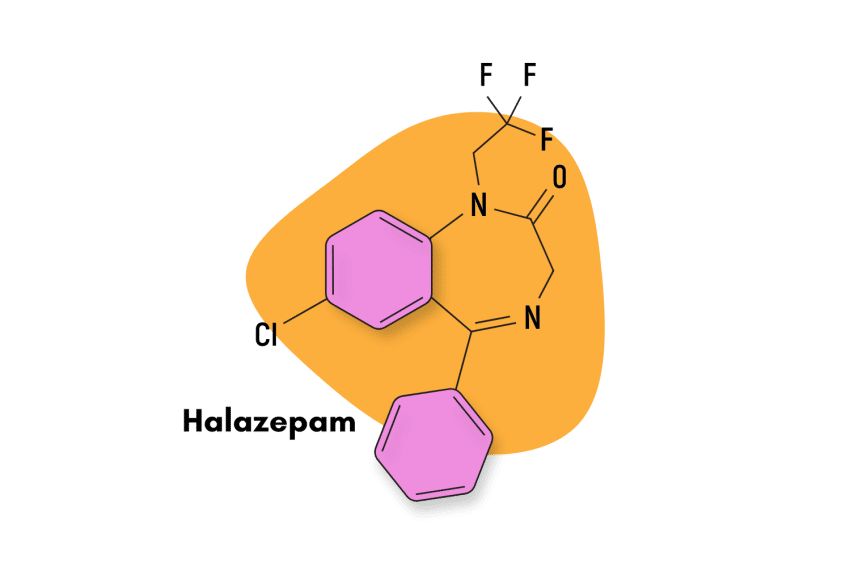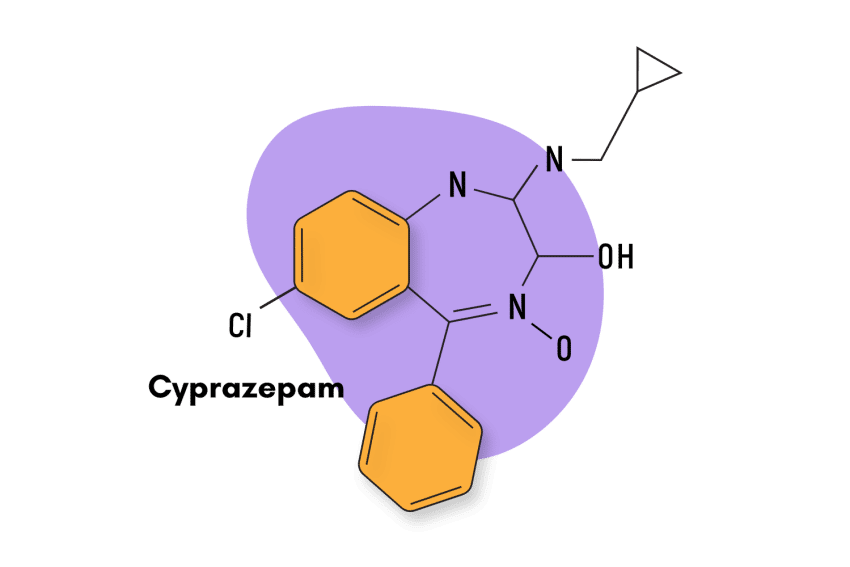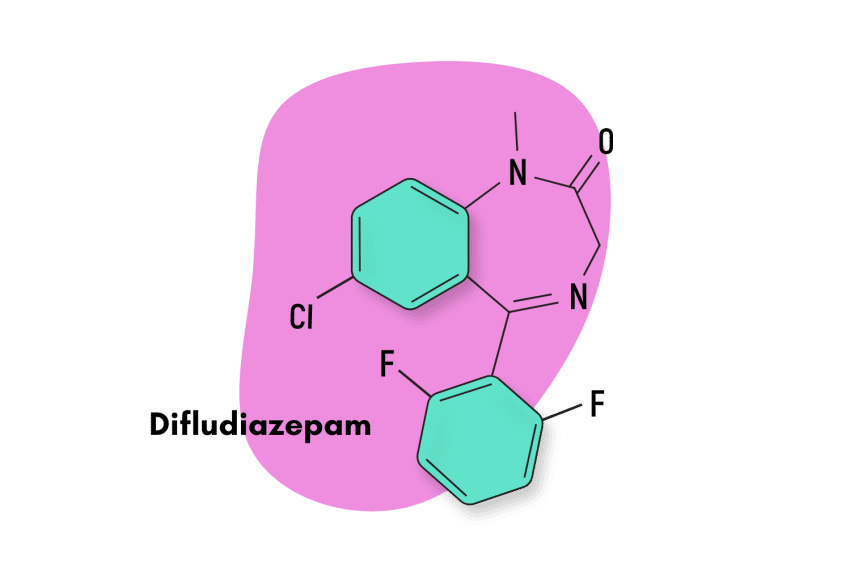Flunitrazolam Fact Sheet: Dosage, Safety, & Alternative Benzodiazepines to Consider Instead

Flunitrazolam, also known as FNTZ or flunazolam, is a designer benzodiazepine of the triazolobenzodiazepine class (TBZDs).
This benzodiazepine subtype is characterized by the presence of a triazole ring fused to a diazepine ring, as well as their incredible levels of potency and marked antidepressant effects.
Specifically, flunitrazolam is the triazole analog of flunitrazepam (Rohypnol). It’s believed to be significantly more potent than this already powerful benzodiazepine derivative.
Indeed, several of the most potent benzodiazepines belong to the TBZD class, and flunitrazolam is no exception: studies show that this benzo is active even at sub-milligram doses [1], making it particularly risky when it comes to overdoses.
Before it was flagged by the European EMCDDA Early Warning System in 2016, there was no record of flunitrazolam in either the scientific or patent literature. Consequently, there is limited knowledge about the specifics of this compound.
In recent years, however, some progress has been made in terms of its characterization, and we can now draw some general conclusions about its nature as a benzodiazepine compound.
Flunitrazolam Specs:
| Status: | Research Chemical |
| Common Dosage: | 1-2 mg |
| PubChem ID: | 137700379 |
| CAS# | 2243815-18-9 |
IUPAC Name:
6-(2-Fluorophenyl)-1-methyl-8-nitro-4H-[1,2,4]triazolo[4,3-a][1,4]benzodiazepine
Other Names: FNTZ, flunazolam
Metabolism:
At the moment, only a few studies have attempted to determine the metabolic profile of flunitrazolam. From what we can gather, the metabolic transformation of flunitrazolam happens through monohydroxylation, dihydroxylation, and, finally, the reduction of the nitro function [2].
Four potential metabolites have been proposed for flunitrazolam (FNTZ): 4-hydroxy-FNTZ, desnitro-FNTZ, 7-amino-FNTZ, and 7-acetamido-FNTZ [3]. It is not yet clear whether these metabolites exert pharmacological actions of their own, but we do know their identification improves the detection window for flunitrazolam for up to 37 hours.
Duration of Effects:
The half-life of flunitrazolam is 5 to 13 hours, while its duration of effects is four to eight. When compared to other benzos, this would make flunitrazolam a short-acting benzodiazepine.
Flunitrazolam Dosage
Flunitrazepam is a recreational drug, and, as such, there is no “proper dosage” since it isn’t indicated for any medical purposes.
With that said, the common recreational dosage seems to range from 0.5 mg to 1 mg.
It’s also worth mentioning that, in terms of dosage, flunitrazolam has a steep progression from regular strength into “blackout” level effects.
We do not condone recreational use, but for this reason, we do suggest that recreational users exercise extreme caution when determining the dosage of flunitrazolam.
Benzodiazepine Equivalence Calculator
**Caution:** Benzodiazepines have a narrow therapeutic window. Dose equivalents may not be accurate in higher doses.
This calculator does not substitute for clinical experience and is meant to serve only as a reference for determining oral benzodiazepine equivalence.
Please consult a medical practitioner before taking benzodiazepines.
How Does Flunitrazolam Work?
Non-atypical benzodiazepines like flunitrazolam produce a variety of effects by binding to the benzodiazepine receptor site on gamma-aminobutyric acid (GABA) receptors. This magnifies the potency of the body’s natural GABA — resulting in widespread suppression of neurological function.
When the nervous system is suppressed, anxiety levels diminish, we feel more calm and relaxed, the muscles stop contracting, and we may begin to feel tired and sedated. This effect can also produce a feeling similar to alcohol or GHB, along with side effects like fatigue, amnesia, and disinhibition.
There is evidence for the involvement of secondary mechanisms of action, though, like, for example, the anticonvulsant properties of benzodiazepines being partly linked to voltage-dependent sodium channel binding as opposed to GABA-A receptor binding [4].
Despite the presence of other mechanisms other than the primary GABA-mediated pathway, the general effects profile for nearly all benzodiazepines is determined by GABA-A interaction and is the reason why these compounds have a shared nature.

Flunitrazolam Specifics
We don’t have a solid body of scientific evidence to fall back on to determine the unique characteristics of flunitrazolam’s effects. This lack of clinical information means we’re forced to rely on subjective studies which attempt to glean pharmacological insights based on what effects these benzodiazepines produce. These types of studies often use the information found on various online forums where designer drug users discuss their experiences.
Given this situation, conclusions about flunitrazolam’s effects and nature should be treated with a healthy degree of speculation.
Preliminary insight into flunitrazolam suggests this compound is extremely potent and has a strong predisposition for sedative effects, muscle relaxation, amnesia, and the suppression of emotions.
Some users have also reported that high doses of flunitrazolam can induce seizures unrelated to withdrawal symptoms: for a benzodiazepine compound, this is an unusual particularity and definitely a cause for concern [5].
In terms of pharmacokinetics, we know that flunitrazolam is a short-acting compound. Benzodiazepines that are both potent and short-acting, like flunitrazolam, tend to be favored by the recreational drug community.
Due to their structural similarities with tricyclic antidepressant medications, benzodiazepines in the TBZD class normally have strong anxiolytic effects. Subjective reports imply this is not the case for flunitrazolam, though, as hypnotic and muscle-relaxant properties seem to be stronger.

Is Flunitrazolam Safe? Risks & Side-Effects
In many countries including the United States, flunitrazolam is not a controlled substance.
In fact, the legal status of designer drugs like flunitrazolam is somewhat of a grey area. Although their purchase may not be technically illegal, these compounds are mostly intended to be used as research chemicals. Thus their recreational consumption and/or distribution may face penal consequences.
Considering that virtually all benzodiazepine compounds share a considerable baseline risk level which is tied to their primary mechanism of action, this state of affairs does not make much sense. The vast majority of these compounds all share the same Schedule IV classification on the Controlled Substances Act.
This means that despite their recognized medical uses, benzodiazepines can be abused and may cause physical dependence and withdrawal symptoms.
However, flunitrazolam is one of the only members listed under Schedule III, which suggests this drug carries a higher risk of abuse than other members of the class.
Even though we have a good understanding of the risks associated with benzodiazepine use, the scant evidence for flunitrazolam forces us to make general assumptions when it comes to its risk profile.
In this sense, the elevated potency of flunitrazolam is likely the most significant factor to watch out for: this trait tends to raise the abuse potential of benzodiazepines and makes the occurrence of serious health events, like overdoses, more likely.
Side Effects of Flunitrazolam
There are no studies that attempt to directly determine flunitrazolam’s side effects.
Nevertheless, due to the common nature of benzodiazepines and the studies performed on flunitrazolam’s parent compound, flunitrazepam, we can still offer a side effects profile that is likely similar.
The most common side effects of flunitrazepam are those related to its hypnotic properties, such as residual sedation, drowsiness, amnesia, and disinhibition.
Other side effects identified with flunitrazepam may include [6]:
- Aggression
- Amnesia (blackout)
- Confusion
- Excitability
- Headaches
- Impaired reaction time and motor coordination
- Impaired mental functioning and judgment
- Sedation
- Sleep
- Slowed breathing and heart rate
- Slurred speech
Flunitrazepam also happens to be one of the few approved benzodiazepine medications which are listed as a Schedule III compound rather than Schedule IV, and this is due to its incredibly powerful amnesic effects. Indeed, the capacity of flunitrazepam to create an almost total memory blackout on users is so powerful, and its consequent use as an illegal date-rape drug is so pervasive that governmental authorities have made strong moves to limit its availability.
There is usually a fair amount of similarity when it comes to parent compounds and their derivatives. With some reasonable speculation, we can assume the side effects of flunitrazepam are at least somewhat comparable to that of its parent, flunitrazolam.
Benzodiazepine Withdrawal & Dependence
The GABA-A mediated pathway utilized by benzodiazepines is known to have the potential to cause symptoms of physical dependence as well as withdrawal symptoms. There is a fair bit of variation related to factors such as pharmacokinetics and potency, but after a certain time period, the possibility of dependence as a consequence of consecutive benzodiazepine use is significant.
To hedge against this possibility, doctors limit benzodiazepine treatment to just a few weeks. They also limit the dose to the lowest amount possible.
Research has shown these two factors are the most significant in the formation of physical benzodiazepine dependence.
But there are other meaningful factors users must consider, such as potency (the higher the potency, the more likely one is to become dependent on the drug) and elimination half-life (shorter-acting compounds have been linked to higher dependence risk).
As a potent, short-acting compound, flunitrazolam exhibits a profile that is skewed toward the formation of physical dependence. It’s also a designer drug with a high penchant for recreational use, making it even more prone to dependence-forming behaviors.

Harm Reduction: Flunitrazolam
Benzodiazepine Harm Reduction Tips:
- 🥣 Don’t mix — Mixing benzodiazepines with other depressants (alcohol, GHB, phenibut, barbiturates, opiates) can be fatal.
- ⏳ Take frequent breaks or plan for a short treatment span — Benzodiazepines can form dependence quickly, so it’s important to stop using the drug periodically.
- 🥄 Always stick to the proper dose — The dosage of benzos can vary substantially. Some drugs require 20 or 30 mg; others can be fatal in doses as low as 3 mg.
- 💊 Be aware of contraindications — Benzodiazepines are significantly more dangerous in older people or those with certain medical conditions.
- 🧪 Test your drugs — If ordering benzos from unregistered vendors (online or street vendors), order a benzo test kit to ensure your pills contain what you think they do.
- 💉 Never snort or inject benzos — Not only does this provide no advantage, but it’s also extremely dangerous. Benzos should be taken orally.
- 🌧 Recognize the signs of addiction — Early warning signs are feeling like you’re not “yourself” without the drug or hiding your habits from loved ones.
- ⚖️ Understand the laws where you live — In most parts of the world, benzodiazepines are only considered legal if given a prescription by a medical doctor.
- 📞 Know where to go if you need help — Help is available for benzodiazepine addiction; you just have to ask for it. Look up “addiction hotline” for more information where you live. (USA: 1-800-662-4357; Canada: 1-866-585-0445; UK: 0300-999-1212).
Flunitrazolam Drug Interactions
Flunitrazolam, like all benzodiazepine compounds, should never be mixed with other drugs that have the capability to depress the central nervous system (CNS), like opioids, barbiturates, alcohol, GHB, phenibut, or even natural compound like kava or kratom.
Concomitant use of CNS depressants leads to a mutual potentiation of the effects of each drug, and the end result is a higher risk of overdosing on either substance.
Such a strong depressive effect can have various detrimental effects on the body, but the major cause for concern is the potential for severe respiratory depression: this condition is a common consequence of poly-drug abuse and is the leading cause of death among drug overdoses.
Flunitrazolam Contraindications
A contraindication refers to a situation where users are at a higher level of risk than normal when taking a given drug. These conditions are used to rule out high-risk individuals before a doctor prescribes a medication.
Flunitrazepam is contraindicated for the following conditions/compounds:
- Bronchitis
- Chronic obstructive pulmonary disease (COPD)
- Conjunctive use of barbiturates, opiates, or those suffering from alcoholism
- Intellectual disabilities due to frequent paradoxical reactions
- Major depression
- Myasthenia gravis
- Over the age of 65 (high risk)
- Personality disorders
- Pregnancy and lactation
- Sleep apnea

Similar Benzodiazepines
From what we know about flunitrazolam, there’re a number of other benzodiazepine compounds which share a high degree of similarity with it. You can find some of these compounds in the following list:
Flunitrazepam
Flunitrazepam is a 1,4-benzodiazepine and the parent compound of flunitrazolam.
There’s a substantial level of similarity when it comes to the effects of these two compounds. However, there are two main differences to be aware of:
First, flunitrazepam is a long-acting compound (35 hours), and flunitrazolam a short-acting one (5 to 13).
The other is potency — flunitrazolam is thought to be anywhere from 2 to 5 times more potent than flunitrazepam.
Flubromazolam
Flubromazolam (also known as liquid Xanax) is another extremely powerful designer benzodiazepine compound of the TBZD class.
This compound began to appear in designer drug databases around the same time as flunitrazolam, and even though flubromazolam is slightly longer lasting, they are both popular for the same inherent reasons: high potency coupled with a short duration of effects.
Natural Alternatives to Benzodiazepines
First and foremost, no natural alternatives will provide comparable potency to synthetic benzodiazepines. However, along with their more gentle nature, plants with benzodiazepine-like activity carry a substantially lower risk for side effects, abuse, and long-term neurological damage.
Natural alternatives to benzodiazepines like kava (Piper methysticum) or valerian (Valeriana officinalis) are now widely available and are becoming more and more popular with each passing year. Both of these plants contain compounds that work through the same mechanisms as benzodiazepines — by modulating the GABA-A receptors located throughout the central nervous system.
Other herbs with similar effects include chamomile (Matricaria chamomilla), kratom (Mitragyna speciosa), and L-theanine (one of the active ingredients in green tea).
Flunitrazolam FAQs
When does flunitrazolam reach peak blood level concentrations?
Studies have found that flunitrazolam reaches peak blood level concentrations three hours after ingestion [5].
What are the structural features of flunitrazolam?
Flunitrazolam is named for the fluorine, bromine, and triazole substitutions on its core benzodiazepine skeleton. Flunitrazolam is a member of the benzodiazepine class as it contains a 1,4 diazepine ring fused to a substituted benzene ring; it also has a bromine molecule bound to this bicyclic structure at R7, as well as a fluorine substituted phenyl ring bound to at R5. Flunitrazolam also contains a methylated triazole ring fused to and incorporating R1 and R2 of its diazepine ring.
References
- Ameline, A., Richeval, C., Gaulier, J. M., Raul, J. S., & Kintz, P. (2018). Characterization of flunitrazolam, a new designer benzodiazepine, in oral fluid after a controlled single administration. Journal of Analytical Toxicology, 42(6), e58-e60.
- Moosmann, B., Bisel, P., Westphal, F., Wilde, M., Kempf, J., Angerer, V., & Auwärter, V. (2019). Characterization and in vitro phase I microsomal metabolism of designer benzodiazepines: An update comprising flunitrazolam, norflurazepam, and 4’‐chlorodiazepam (Ro5–4864). Drug Testing and Analysis, 11(3), 541-549.
- Ameline, A., Richeval, C., Gaulier, J. M., Raul, J. S., & Kintz, P. (2019). Detection of the designer benzodiazepine flunitrazolam in urine and preliminary data on its metabolism. Drug testing and analysis, 11(2), 223-229.
- McLean, M. J., & Macdonald, R. L. (1988). Benzodiazepines, but not beta carbolines, limit high-frequency repetitive firing of action potentials of spinal cord neurons in cell culture. J Pharmacol Exp Ther, 244(2), 789-95.
- Ameline, A., Richeval, C., Gaulier, J. M., Raul, J. S., & Kintz, P. (2018). Characterization of flunitrazolam, a new designer benzodiazepine, in oral fluid after a controlled single administration. Journal of Analytical Toxicology, 42(6), e58-e60.
- Substance Abuse and Mental Health Services Administration (US); Office of the Surgeon General (US). Facing Addiction in America: The Surgeon General’s Report on Alcohol, Drugs, and Health [Internet]. Washington (DC): US Department of Health and Human Services; 2016 Nov. [Table], Rohypnol® (Flunitrazepam)









